2. 中国农业科学院农业环境与可持续发展研究所,北京 100081;
3. 中国农业大学华北耕地保育重点实验室,北京 100193
2. Institute of Environment and Sustainable Development in Agriculture, Chinese Academy of Agricultural Sciences, Beijing 100081, China;
3. Key Laboratory of Arable Land Conservation in North China, China Agricultural University, Beijing 100193, China
生物炭 (biochar) 可由富含碳的生物质在少氧环境条件下缓慢高温 (大于250℃) 分解得到[1],其原材料可为农作物秸秆、木质材料、动物粪便和其他有机废弃物等[2]。将生物质炭施入土壤后,对土壤性质及作物生长能够产生一定的影响。已有研究表明,生物质炭可以提高土壤持水量和养分含量[3],提高土壤温度和改良土壤质地[4],增强土壤微生物活性,从而提高土壤肥力[5]。但关于生物质炭对作物产量的影响目前还具有不确定性。张登晓等[6]的研究表明,在温室盆栽中施用生物质炭能显著提高小白菜的产量,增产幅度最高达75%,同时可降低小白菜中的硝酸盐含量。Baronti等[7]用沙壤土做盆栽试验,当生物质炭施用量为30 t/hm2和60 t/hm2时,黑麦草的生物量分别比对照增加20%和52%,但施用量提高到100 t/hm2和200 t/hm2时,反而比对照降低8%和30%。Rondon等[8]研究指出,当生物质炭施用量为30 g/kg和60 g/kg时,可显著增加大豆产量,但当生物质炭施用量增至90 g/kg时,与对照相比,大豆产量不增反降,这表明一定量的生物质炭可以促进作物的生长,但过量施用反而不利于作物的生长。此外,生物质炭可显著降低叶菜类蔬菜硝酸盐含量[6],改善蔬菜营养品质[9–10]。牛亚茹等[10]在大棚栽培中施用生物质炭,当生物质炭施用量为48 t/hm2时,可显著增加黄瓜可溶性糖和有机酸含量,降低黄瓜硝酸盐含量。
近年来,我国蔬菜种植面积持续快速增长。到2012年,我国已成为世界上最大的温室蔬菜生产国[11]。设施栽培在快速发展的过程中也出现各种问题,生产者为了追求较高的经济利益,大量施用化肥,导致设施菜地土壤出现不同程度的次生盐渍化和盐害,作物生长发育出现生理障碍,减产幅度不断增加,这些严重阻碍和威胁了设施农业的可持续发展[12]。此外,在蔬菜栽培过程中,相较于茄果类和葱蒜类,叶菜类蔬菜更易富集硝酸盐[13],而人体摄入的72%~94%来自蔬菜[14]。因此,改善设施栽培土壤质量,提高蔬菜产量和品质是蔬菜种植中需要关注的问题。
生物质炭由于其良好的持水保肥性能,可以作为改良剂施入土壤中改善土壤环境,以提高作物产量和品质[15–16]。但目前关于生物质炭不同施用量的研究还无法推出通用的生物质炭最佳施用量范围,需要根据不同土壤类型和作物种类来确定最佳施用量[17]。本试验以设施蔬菜西芹和茄子为研究对象,探究了大棚土壤中添加不同用量的生物质炭对土壤养分以及蔬菜产量和品质的长期影响,从而探索一种绿色可持续发展的设施农业生产方式。同时,也为大棚蔬菜种植中土壤添加生物质炭的用量提供依据。
1 材料与方法 1.1 供试材料试验于2014年11月—2015年7月在北京市顺义区康鑫源基地 (116.65°E、40.13°N) 温室大棚中进行,大棚净生产面积为380 m2。试验蔬菜西芹品种为文图拉,茄子品种为京茄6号。土壤质地为砂质黏壤土,分别含砂粒 (2~0.05 mm) 60.0%、粉粒 (0.05~0.002 mm) 20.2%、粘粒 ( < 0.002 mm)19.8%。耕层 (0—20 cm) 土壤有机碳含量15.20 g/kg、全氮含量1.40 g/kg、全磷含量1.10 g/kg、全钾含量9.40 g/kg、有效磷93.50 mg/kg、速效钾78.30 mg/kg、碱解氮 63.00 mg/kg、pH(水土比2.5∶1)6.72。生物质炭购自沈阳金和福有限公司,由花生壳和锯木在400~500℃下裂解两小时而成,经测定 [18],其有机碳含量688.10 g/kg、全氮含量6.83 g/kg、全磷含量1.90 g/kg、全钾含量15.18 g/kg、有效磷含量242.30 mg/kg、速效钾含量9.54 g/kg。施用的有机肥原材料为动物粪便和植物残体等物质,并利用微生物菌剂经高温发酵而成,其有机质含量310.67 g/kg、全氮含量15.01 g/kg、全磷含量 6.33 g/kg、全钾含量30.88 g/kg。
1.2 试验设计本试验生物质炭施用量共设5个水平,分别为不施用生物质炭 (B0)、施用20 t/hm2 (B20)、40 t/hm2 (B40)、80 t/hm2 (B80)、160 t/hm2 (B160) 生物质炭。采用完全区组设计,每个处理3次重复,共15个小区,每个小区面积为23 m2。2014年10月16日,按照试验设计将全部生物质炭及17.86 t/hm2有机肥料作为底肥一次性施用,耕翻后与耕层土壤充分混合。2014年11月10日移栽西芹,2015年2月25日采收;2015年3月30日移栽茄子,2015年6月6日采收第一批成熟茄子并计产,2015年7月12日采收第二批茄子并计产。为保证茄子生长期的营养需求,于西芹收获一周后 (2015年3月4日),施用35.72 t/hm2有机肥料作为底肥,各小区均匀撒施,与土壤充分混匀 (肥料养分含量见1.1供试材料)。化肥使用按照常规生产进行。西芹与茄子生长期间田间管理均按当地习惯方式进行。
1.3 分析方法植株:西芹收获时,划面积 (1 m2) 测产,采集所选区域内所有西芹植株,称取质量;茄子收获时,采用称重法得到茄子产量;用水杨酸比色法测定西芹组织中硝酸盐含量[19];茄子果实Vc含量采用2,6-二氯靛酚滴定法测定,茄子过氧化氢酶活性采用紫外分光光度法测定[20];西芹植株与茄子果实样品经浓硫酸消煮后,分别采用凯氏定氮法、钒钼黄比色法和分光光度计法[18]测定全氮、全磷、全钾含量。
土壤:分别在西芹收获后 (2015年2月25日)、茄子移栽前 (2015年3月30日)、茄子第二次收获后 (2015年7月12日) 采集土样。每个小区取3钻0—20 cm土壤,混合后装入自封袋备用。土壤碱解氮用碱解扩散法测定;土壤速效钾用火焰光度法测定;土壤有效磷用钼锑抗比色法测定[18]。
1.4 数据分析试验数据用Excel 2013进行统计分析,采用SPSS21.0进行单因素方差分析和多重比较,用LSD法比较处理间的差异显著性 (P < 0.05)。
2 结果与分析 2.1 生物质炭对西芹和茄子产量的影响及经济效益分析由图1可以看出,与不添加生物质炭 (B0) 相比,B20和B160处理能显著提高西芹产量,增产幅度分别达31.6%和30.3%;B40处理西芹增产18.1%,B80处理对西芹产量影响不显著。不同施炭处理对茄子产量影响不显著。
由表1可知,种植两茬作物,B20处理温室大棚两茬蔬菜纯收入 (总收入减去肥料总投入) 最高,为421622元,与B0相比纯收入增加9.4%;而随着生物质炭添加量的增多,肥料投入成本逐渐加大,温室大棚收益反而越来越低。
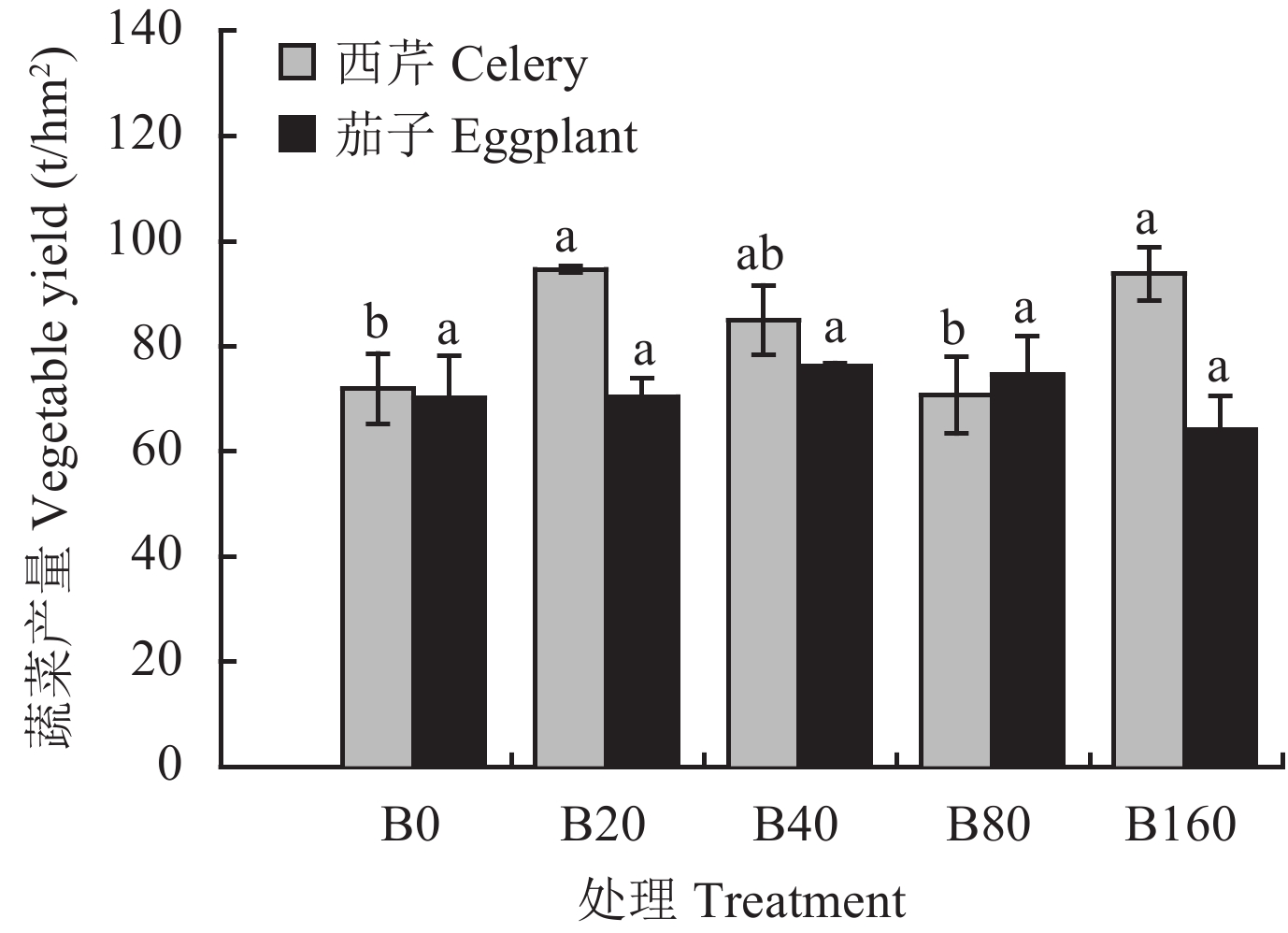 |
| 图1 施用生物质炭对西芹和茄子产量的影响 Fig. 1 Impacts of biochar treatments on yield of celery and eggplant [注 (Note):柱上不同字母表示同一蔬菜不同生物炭处理间差异显著 (P < 0.05) Different letters above the bars mean significant difference among treatments for the same vegetable (P < 0.05).] |
| 表1 不同生物质炭施用量生产成本与产出对比 Table 1 Input and output of different biochar treatments |
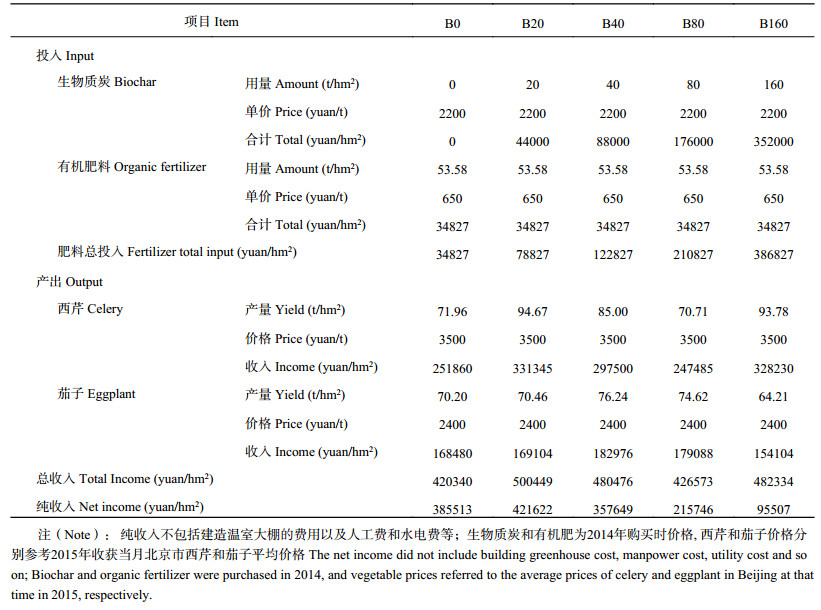 |
从图2可以看出,西芹硝酸盐含量在487.41~1001.08 mg/kg,与B0处理相比,B20处理对西芹植株硝酸盐含量无显著影响,但B40、B80和B160处理显著降低了西芹植株硝酸盐含量,降低幅度分别达37%、37.2%和49.1%,但处理间差异不显著。由此可知,当生物质炭添加量增加至40 t/hm2及以上时,西芹硝酸盐含量能够显著降低。
过氧化氢酶是植物组织中重要的抗氧化酶之一,其活性的高低可在一定程度上体现果实的耐藏性和成熟衰老程度。从图3可以看出,处理间过氧化氢酶活性无显著性差异,说明添加生物质炭对茄子过氧化氢酶活性无显著影响。与不施炭处理相比,添加生物质炭对茄子的维生素C含量影响不明显。
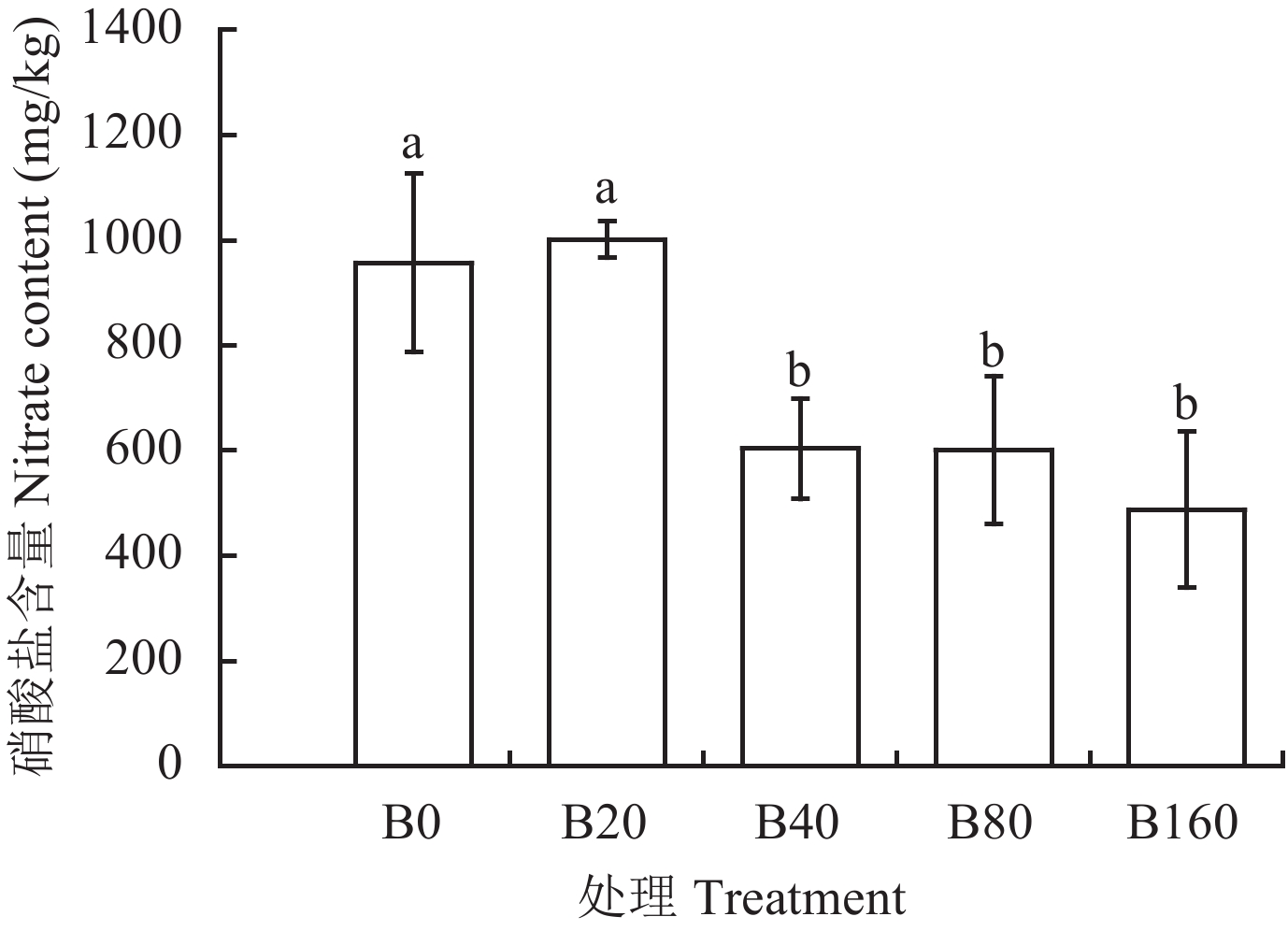 |
| 图2 施用生物质炭对西芹硝酸盐含量的影响 Fig. 2 Impacts of biochar on nitrate content of celery [注(Note):柱上相同字母表示处理间差异不显著 (P < 0.05) The same letters above the bars mean no significant difference among treatments (P < 0.05).] |
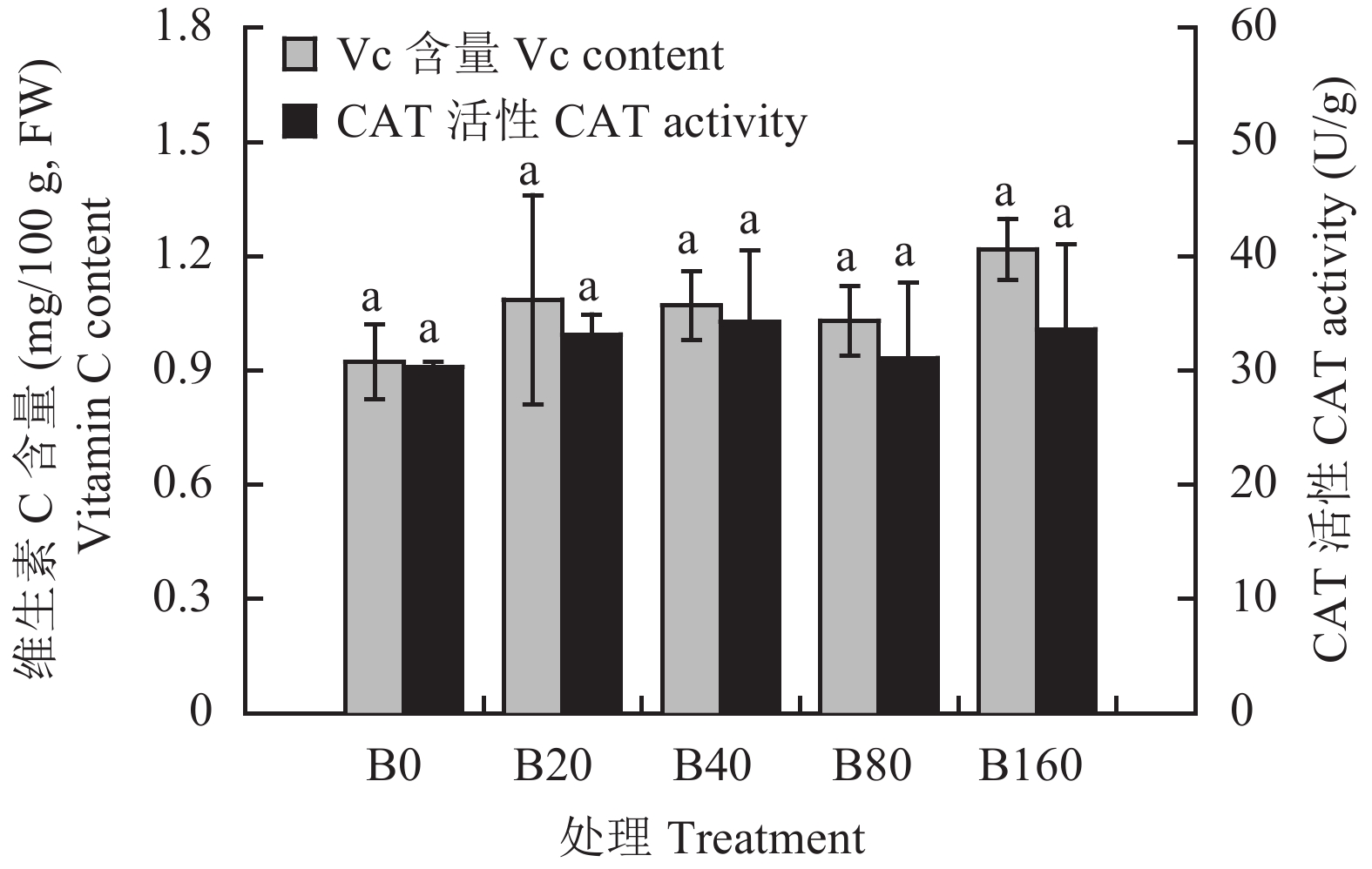 |
| 图3 施用生物质炭对茄子品质的影响 Fig. 3 Impacts of biochar on qualities of eggplant [注 (Note):柱上相同字母表示处理间差异不显著 (P < 0.05) The same letters above the bars mean no significant difference among treatments (P < 0.05).] |
从表2可以看出,与不添加生物质炭相比,生物质炭的施用对西芹氮和磷含量无显著性影响。当生物质炭施用量为40 t/hm2 (B40),西芹全钾含量最低。与不施炭处理相比,添加生物质炭能够不同程度的增加西芹植株氮磷钾积累量,当生物质炭施用量为20 t/hm2时,氮积累量达到最高,当生物质炭施用量为160 t/hm2时,植株磷钾积累量达到最大。
由表2可知,不同生物质炭处理对茄子果实中氮、磷、钾含量均无显著影响。当生物质炭施用量达40 t/hm2和80 t/hm2时 (B40和B80处理),可显著增加茄子果实氮素积累量,但当生物质炭施用量为160 t/hm2时,氮积累量反而有所降低;当生物质炭施用量达40 t/hm2时 (B40),茄子果实磷积累量最高,而B160处理积累量最低。施用生物质炭对茄子果实钾积累量无显著性影响。
| 表2 不同生物质炭添加量下西芹植株和茄子果实氮磷钾含量及积累量 Table 2 The content and accumulation of NPK in celery and eggplant fruit under different biochar additions |
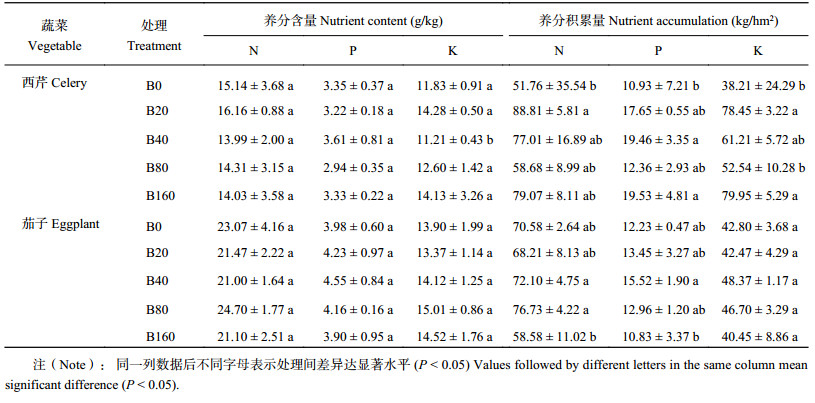 |
由图4a可以看出,西芹收获后与茄子移栽前,各处理土壤碱解氮含量差异不显著;茄子收获后,未施炭处理土壤碱解氮含量最高,B160处理最低。整体变化趋势是,随生物质炭施用量的增加,土壤碱解氮含量逐渐降低,其中,B40、B80和B160处理降低幅度分别达11.7%、10.0%和20.3%。由图4b可以看出,西芹收获后,随着生物质炭施用量的增加,土壤有效磷含量呈逐渐增加的趋势,但各处理间差异不显著。茄子移栽前和茄子收获后,各处理土壤有效磷含量差异均不显著。随着生物质炭施用量的增加,土壤速效钾含量逐渐增加 (图4c)。西芹收获后,B80和B160处理土壤速效钾含量增加幅度分别达95.8%和196.2%;茄子收获后,B160处理土壤速效钾含量增加幅度达165.5%。B160处理土壤速效钾含量最高,不施生物质炭处理最低。
 |
| 图4 不同生物质炭添加量下蔬菜收获前、后的土壤有效态氮磷钾含量 Fig. 4 Soil available N, P and K contents added with different biochar amount before and after crop harvest [注(Note):柱上不同字母表示处理间差异达显著水平 (P < 0.05) Different letters above the bars mean significant difference (P < 0.05).] |
大量的研究表明,生物质炭能够促进作物生长,增加作物产量,但也有不同结果[7–8]。本试验中,B20与B160处理能够显著增加西芹植株产量,说明适量的生物质炭施入能促进西芹植株生物量的积累 (图1)。与此同时,B20与B160处理在生物量增加的同时,植株体内的养分含量并没有下降,表明适量的生物质炭施入能够促进根系对土壤养分的吸收,因此提高了西芹的养分吸收量。这可能与生物质炭能够促进植物根系生长[21]和改善植株根际生长环境[22]有关。B40处理有助于茄子果实氮磷积累,但B160处理果实氮磷积累量却降至最低,钾积累量相较于其他处理也较低,但未出现显著性差异,说明生物质炭施用量过多会抑制茄子生长,影响养分向果实运输转移。类似的研究也表明,施用过量生物质炭能够抑制黑麦草[7]和大豆[8]生长。研究表明,氮素可促进植株干物质积累[23],土壤缺氮不仅影响氮素积累,还会影响磷素与钾素的积累[24]。而本试验中,B160处理降低了茄子土壤碱解氮含量 (图4a),影响了茄子果实干物质积累,故而影响果实氮磷钾养分积累。在本研究中,适量生物质炭 (B20与B160处理) 增加了西芹产量,但却对茄子产量无显著影响。可能有以下三种原因:1) 生物质炭的增产效应随着种植时间增加而减弱[25],主要原因是风化炭养分含量低于新鲜生物质炭[26];2) 种植蔬菜种类不同,需肥特性不同;3) 由本研究结果可知,在两茬作物生长期间,土壤养分状况不同,生物质炭对土壤养分的影响也不尽相同 (图4),这可能是适量生物质炭增加西芹产量却对茄子产量无影响的主要原因。本文研究了生物质炭作为基肥一次性施入土壤后,种植一年蔬菜后的结果,其结果对于温室设施栽培中生物质炭施用量更具有现实指导意义,但其对设施蔬菜更为长久的影响还有待进一步研究。
蔬菜中硝酸盐的含量取决于施用肥料的种类、施用量以及使用时间等因素[27]。在众多蔬菜种类中,由于叶菜类蔬菜耐肥性较强且需肥量大,因此更易富集较高的硝酸盐[13]。本研究中,施用适量生物质炭 (B40、B80和B160处理) 能够降低西芹植株硝酸盐含量,这与张登晓等[6]的研究结论一致。一方面,施用生物质炭后,土壤中氮素释放缓慢[28],作物对硝态氮的吸收来源减少,因而不会因短期内吸收过多氮素而造成硝酸盐积累;另一方面,有可能是植株体内钾含量的增加促进了作物体内硝酸盐的还原同化[29],从而降低了西芹中硝酸盐的含量。生物质炭对茄子维生素C含量和过氧化氢酶活性无显著影响。
生物质炭对土壤养分的影响与生物质炭类型、施用量、土壤类型和气候条件等有密切关系[30]。本研究结果显示,生物质炭显著提高了土壤速效钾含量,且随生物质炭施用量的增加,土壤速效钾含量增高 (图4c),这与谢国雄等[31]的研究结果一致。这可能是由于,一方面,生物质炭含有一定量的速效钾,施入土壤后可显著增加土壤速效钾含量;另一方面,施用生物质炭可增加土壤CEC[32],增加土壤中可交换性钾含量。生物质炭对土壤有效磷含量无显著影响 (图4b),这与Borchard等[33]及Jones等[34]的结论相同。可能是因为生物质炭本身含有的有效磷较少,施入土壤后土壤有效磷含量并无显著增加。施用生物质炭对西芹收获后土壤碱解氮含量无显著影响,但却显著降低了茄子收获后土壤碱解氮含量,且随着施炭量的增加,土壤碱解氮含量逐渐降低 (图4a)。可能是因为,生物质炭增加了土壤有机碳含量,故而增加了土壤碳氮比,从而降低了土壤有效氮含量[35]。生物质炭对土壤性质的影响,因生物质炭施入土壤时间长短、土壤养分状况、作物种类等因素而存在不确定性,其影响机理有待进一步系统深入的研究。
4 结论将不同量的生物质炭施入土壤,先后种植西芹和茄子。总体来看,生物质炭对西芹生长影响更为显著,施用适量生物质炭能够促进西芹植株氮磷钾养分积累,增加产量,降低植株硝酸盐含量。但是,生物质炭对茄子产量和品质均无显著影响,当施用量过高时,反而抑制了茄子果实养分积累。施用生物质炭有效增加了土壤速效钾含量,对土壤有效磷含量无显著影响,对土壤碱解氮含量的影响较为复杂,即对西芹收获后土壤碱解氮含量无显著影响,却降低了茄子收获后土壤碱解氮含量。生物质炭对土壤养分的长期影响如何,以及生物质炭针对不同作物的合适用量,还有待进一步的研究。
| [1] | Lehmann J D, Joseph S. Biochar for environmental management: science, technology and implementation [M]. New York: Routledge, 2015. 39–57. |
| [2] | Dong D, Feng Q, McGrouther K, et al. Effects of biochar amendment on rice growth and nitrogen retention in a waterlogged paddy field[J]. Journal of Soils and Sediments, 2015, 15(1): 153–162. DOI:10.1007/s11368-014-0984-3 |
| [3] | Zheng H, Wang Z, Deng X, et al. Characteristics and nutrient values of biochars produced from giant reed at different temperatures[J]. Bioresource Technology, 2013, 130: 463–471. DOI:10.1016/j.biortech.2012.12.044 |
| [4] | Laird D A, Brown R C, Amonette J E, Lehmann J. Review of the pyrolysis platform for coproducing bio-oil and biochar[J]. Biofuels, Bioproducts and Biorefining, 2009, 3(5): 547–562. DOI:10.1002/bbb.v3:5 |
| [5] | Gul S, Whalen J K. Biochemical cycling of nitrogen and phosphorus in biochar–amended soils[J]. Soil Biology and Biochemistry, 2016, 103: 1–15. DOI:10.1016/j.soilbio.2016.08.001 |
| [6] |
张登晓, 周惠民, 潘根兴, 等. 城市园林废弃物生物质炭对小白菜生长、硝酸盐含量及氮素利用率的影响[J].
植物营养与肥料学报, 2014, 20(6): 1569–1576.
Zhang D X, Zhou H M, Pan G X, et al. Effect of municipal green waste biochar addition on the growth, nitrate content and nitrogen use efficiency of greenhouse pakchoi[J]. Journal of P1ant Nutrition and Ferti1izer, 2014, 20(6): 1569–1576. |
| [7] | Baronti S. The biochar option to improve plant yields: first results from some field and pot experiments in Italy[J]. Italian Journal of Agronomy, 2012, 5(1): 3–12. |
| [8] | Rondon M A, Lehmann J, Ramírez J, Hurtado M. Biological nitrogen fixation by common beans (Phaseolus vulgaris L.) increases with bio-char additions [J]. Biology and Fertility of Soils, 2007, 43(6): 699–708. DOI:10.1007/s00374-006-0152-z |
| [9] |
赵明, 蔡葵, 孙永红, 等. 污泥生物质炭的碳氮矿化特性及其对大棚番茄产量品质的影响[J].
中国农学通报, 2014, 30(1): 215–220.
Zhao M, Cai K, Sun Y H, et al. Carbon, nitrogen mineralization and effects on yield and quality of tomato in greenhouse of biochar made by sludge[J]. Chinese Agricultural Science Bulletin, 2014, 30(1): 215–220. |
| [10] |
牛亚茹, 付祥峰, 邱良祝, 等. 施用生物质炭对大棚土壤特性、黄瓜品质和根结线虫病的影响[J].
土壤, 2017, 49(1): 57–62.
Niu Y R, Fu X F, Qiu L Z, et al. Effects of biochar on soil properties, cucumber quality and root–knot nematode disease in plastic greenhouse[J]. Soils, 2017, 49(1): 57–62. |
| [11] | Chen Y, Huang B, Hu W, et al. Environmental assessment of closed greenhouse vegetable production system in Nanjing, China[J]. Journal of Soils and Sediments, 2013, 13(8): 1418–1429. DOI:10.1007/s11368-013-0729-8 |
| [12] |
朱白澍, 梁涛. 我国设施农业土壤障碍现状[J].
磷肥与复肥, 2010, 25(3): 73–75.
Zhu B S, Liang T. Status of soil obstacle of facility agriculture in China[J]. Phosphate & Compound Fertilizer, 2010, 25(3): 73–75. DOI:10.3969/j.issn.1007-6220.2010.03.030 |
| [13] |
杨芸, 王崇力, 徐卫红, 等. 重庆市菜园土壤与蔬菜硝酸盐和亚硝酸盐含量及相关性研究[J].
食品科学, 2014, (14): 136–140.
Yang Y, Wang C L, Xu W H, et al. Nitrate and nitrite contents and correlations of vegetables with soil in Chongqing[J]. Food Science, 2014, (14): 136–140. DOI:10.7506/spkx1002-6630-201414026 |
| [14] |
姚春霞, 陈振楼, 陆利民, 等. 上海市郊菜地土壤和蔬菜硝酸盐含量状况[J].
水土保持学报, 2005, 19(1): 84–88.
Yao C X, Chen Z L, Lu L M, et al. Nitric nitrogen content of soil and vegetable in Shanghai suburb[J]. Journal of Soil and Water Conservation, 2005, 19(1): 84–88. DOI:10.3321/j.issn:1009-2242.2005.01.021 |
| [15] | Laird D A, Fleming P, Davis D D, et al. Impact of biochar amendments on the quality of a typical Midwestern agricultural soil[J]. Geoderma, 2010, 158(3–4): 443–449. |
| [16] | Chan K Y, Van Zwieten L, Meszaros I, et al. Agronomic values of greenwaste biochar as a soil amendment[J]. Soil Research, 2008, 45(8): 629–634. |
| [17] |
张文玲, 李桂花, 高卫东. 生物质炭对土壤性状和作物产量的影响[J].
中国农学通报, 2009, 25(17): 153–157.
Zhang W L, Li G H, Gao W D. Effect of biomass charcoal on soil character and crop yield[J]. Chinese Agricultural Science Bulletin, 2009, 25(17): 153–157. |
| [18] |
鲍士旦. 土壤农化分析(第三版)[M]. 北京: 中国农业出版社, 2000.
Bao S D. Soi1 and agro-chemistry ana1ysis (3rd Ed.) [M]. Beijing: China Agricultural Press, 2000. |
| [19] |
王学奎. 植物生理生化实验原理和技术(第二版)[M]. 北京: 高等教育出版社, 2006. 122–123.
Wang X K. Experimental principle and technique for plant physiology and biochemistry (2nd Edition)[M]. Beijing: Higher Education Press, 2006. 122–123. |
| [20] |
高俊凤. 植物生理学实验指导[M]. 北京: 高等教育出版社, 2006. 200–215.
Gao J F. Plant physiology experiment guide [M]. Beijing: Higher Education Press, 2006. 200–215. |
| [21] |
李中阳, 齐学斌, 樊向阳, 等. 生物质炭对冬小麦产量, 水分利用效率及根系形态的影响[J].
农业工程学报, 2015, 31(12): 119–124.
Li Z Y, Qi X B, Fan X Y, et al. Influences of biochars on growth, yield, water use efficiency and root morphology of winter wheat[J]. Transactions of the Chinese Society of Agricultural Engineering, 2015, 31(12): 119–124. DOI:10.11975/j.issn.1002-6819.2015.12.016 |
| [22] | Warnock D D, Lehmann J, Kuyper T W, Rillig M C. Mycorrhizal responses to biochar in soil–concepts and mechanisms[J]. Plant and soil, 2007, 300(1–2): 9–20. |
| [23] |
汪耀富, 孙德梅, 徐传快, 程玉渊. 干旱胁迫下氮用量对烤烟养分积累与分配及烟叶产量和品质的影响[J].
植物营养与肥料学报, 2004, 10(3): 306–311.
Wang Y F, Sun D M, Xu C K, Cheng Y Y. Effects of nitrogen rates on accumulation and distribution of nutrients and the yield and quality of flue–cured tobacco under drought stress[J]. Plant Nutrition and Fertilizer Science, 2004, 10(3): 306–311. DOI:10.3321/j.issn:1008-505X.2004.03.017 |
| [24] |
高志红, 陈晓远, 林昌华, 等. 不同施肥水平对木薯氮磷钾养分积累、分配及其产量的影响[J].
中国农业科学, 2011, 44(8): 1637–1645.
Gao Z H, Chen X Y, Lin C H, et al. Effect of fertilizer application rates on cassava N, P, K accumulations and allocation and yield in sloping lands of north Guangdong[J]. Scientia Agricultura Sinica, 2011, 44(8): 1637–1645. |
| [25] |
肖 婧, 王传杰, 黄 敏, 等. 生物质炭对设施大棚土壤性质与果蔬产量影响的整合分析[J].
植物营养与肥料学报, 2018, 24(1): 228–236.
Xiao J, Wang C J, Hang M, et al. Meta–analysis of biochar application effects on soil fertility and yields of fruit and vegetables in greenhouse[J]. Journal of Plant Nutrition and Fertilizers, 2018, 24(1): 228–236. |
| [26] |
吴伟祥, 孙雪, 董达, 等. 生物质炭土壤环境效应[M]. 北京: 科学出版社, 2015. 253–288.
Wu W X, Sun X, Dong D, et al. Environmental effects of biochar in soil [M]. Beijing: Science Press, 2015. 253-288. |
| [27] | Zhou Z Y, Wang M J, Wang J S. Nitrate and nitrite contamination in vegetables in China[J]. Food Reviews International, 2000, 16(1): 61–76. DOI:10.1081/FRI-100100282 |
| [28] | Khan M A, Kim K W, Wang M Z, et al. Nutrient-impregnated charcoal: An environmentally friendly slow-release fertilizer[J]. Environmentalist, 2008, 28(3): 231–236. DOI:10.1007/s10669-007-9133-5 |
| [29] |
尹红娟, 孙文彦. 新型含钾液体肥料对日光温室芹菜生长和硝酸盐含量的影响[J].
磷肥与复肥, 2009, 24(6): 82–83.
Yin H J, Sun W Y. Effects of new potassium containing liquid fertilizer on growth and nitrate concentration of celery in greenhouse[J]. Phosphate & Compound Fertilizer, 2009, 24(6): 82–83. DOI:10.3969/j.issn.1007-6220.2009.06.031 |
| [30] | Lehmann J, Rondon M. Bio-char soil management on highly weathered soils in the humid tropics[J]. Biological Approaches to Sustainable Soil Systems, 2006, 113(517): e530. |
| [31] |
谢国雄, 王道泽, 吴耀, 等. 生物质炭对退化蔬菜地土壤的改良效果[J].
南方农业学报, 2014, 45(1): 67–71.
Xie G X, Wang D Z, Wu Y, et al. Ameliorating effects of biochar application on degraded vegetable soil[J]. Journal of Southern Agriculture, 2014, 45(1): 67–71. DOI:10.3969/j:issn.2095-1191.2014.1.67 |
| [32] |
袁金华, 徐仁扣. 生物质炭的性质及其对土壤环境功能影响的研究进展[J].
生态环境学报, 2011, 20(4): 779–785.
Yuan J H, Xu R K. Progress of the research on the properties of biochars and their influence on soil environmental functions[J]. Ecology and Environmental Sciences, 2011, 20(4): 779–785. DOI:10.3969/j.issn.1674-5906.2011.04.034 |
| [33] | Borchard N, Wolf A, Laabs V, et al. Physical activation of biochar and its meaning for soil fertility and nutrient leaching–a greenhouse experiment[J]. Soil Use and Management, 2012, 28(2): 177–184. DOI:10.1111/sum.2012.28.issue-2 |
| [34] | Jones D L, Rousk J, Edwards-Jones G, et al. Biochar–mediated changes in soil quality and plant growth in a three year field trial[J]. Soil Biology and Biochemistry, 2012, 45: 113–124. DOI:10.1016/j.soilbio.2011.10.012 |
| [35] |
何绪生, 张树清, 佘雕, 等. 生物炭对土壤肥料的作用及未来研究[J].
中国农学通报, 2011, 27(15): 16–25.
He X S, Zhang S Q, She D, et al. Effects of biochar on soil and fertilizer and future research[J]. Chinese Agricultural Science Bulletin, 2011, 27(15): 16–25. |
 2018, Vol. 24
2018, Vol. 24  doi:
doi: 

